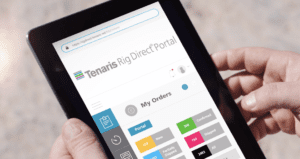For the past several years, Tenaris S.A., a global manufacturer of steel pipes and related items with $7.29 billion in 2019 sales, has been building out a program it calls Rig Direct® that sells and delivers its products directly to its oil-and-gas industry customers’ oil production sites.
“Our service is not to a distribution yard—it’s to the oil-drilling rig,” says Alejandro Lammertyn, chief digital and information officer. “It’s clearly a disruption from the way this market has been.” The Rig Direct service includes help in planning oil well projects, integrating supply chains and what Tenaris describes as “well integrity” support to deliver the exact products and services customers need.
Faced with fluctuating demand for oil—which was down earlier this year from overproduction before the coronavirus further lowered demand—“the oil companies are trying to reduce their costs, they’re trying to simplify their processes,” he adds.
Going more digital
Now, going more digital is a crucial strategy Tenaris is deploying to better serve customers and build stronger relationships with them. The strategy is designed so that Tenaris will use its digital platform to keep learning how to better interact with customers over the long term and address their needs.
In the past two years, the company has updated the Rig Direct business model with a digital transformation strategy that is moving many of its customers into online ordering and providing operational efficiencies for Tenaris and its customers alike, Lammertyn says.
“We have a direct relationship with all of our customers, but we wanted to enhance our long-term relationships,” Lammertyn says, adding: “We needed to enhance the customer experience. We had the physical relationships with customers in terms of delivering the pipes, but we were not integrating the administrative part—how customers place orders, how we trace materials, track invoices, expedite commerce documents and certificates for proof of delivery.”
To provide that higher level of administrative service while building a whole new kind of customer experience, Tenaris launched two years ago a digital platform that lets Rig Direct customers place orders and manage them through the Rig Direct Portal ecommerce site and a related web app.

The Rig Direct mobile app.
Transforming business
“We are making investments in digital technologies to transform the efficiency of our operations and provide customers digital integration efficiencies under our Rig Direct program,” Paolo Rocca, the chairman of Tenaris, said in a letter to stockholders in the company’s 2019 annual report. “These investments are contributing to lower industrial and supply chain costs and closer collaboration with key customers.”
The digital platform is quickly gaining adoption among customers, Lammertyn says. The full Rig Direct program, which launched four years ago, accounts for about 70% of Tenaris’s sales in the United States, where about 50% of Rig Direct customers place orders through the Rig Direct Portal, which debuted in early 2020, he says.
In the Permian Basin region in Texas and New Mexico—known as the largest petroleum-producing basin in the United States—customers use the Rig Direct Portal to manage more than 90% of their orders of casing pipe used in oil rig construction, Tenaris says.
The Rig Direct Portal is integrated with Tenaris’s enterprise resource planning system, which has enabled the manufacturer to increase the efficiency of managing customers’ online orders, it says. Tenaris developed the portal in-house on a digital commerce platform based on .Net technology, Lammertyn says. Initially launched for the U.S. market, the portal is now also available to Tenaris customers in Colombia, Argentina and Mexico.
The digital platform is also bringing other benefits, he says. “We’re now reducing a lot of our customers’ back-office work. And we’re reducing the total cost of operations for our customers and for us.”
From Permian Basin to Indonesia
In the big oil-and-gas companies, saving administrative steps and time in the purchasing process makes a big difference for them, Lammertyn says. Many companies have reduced their back-office work and are moving their administrative operations to shared services. “For a purchase transaction happening in the shale oil sector in the U.S. Permian Basin, they may have a back-office in Indonesia,” he says. “Their process of approval may go to Indonesia to get an invoice approved for it to be paid to us.”
But by putting everything on a digital commerce platform, that oil company’s personnel in the U.S. and overseas can view the same updated information on orders and invoices. As a result, companies using the platform are expediting invoice approvals. “The shift can be from 20 or 30 days to one hour,” Lammertyn says. “Big difference.”
The new ecommerce portal and app, he says, were customer-driven in their design and purpose. “It’s all about enhancing the customer experience,” he says. “Every solution we develop and every digital tool we deploy aim to simplify the administrative process for customers. Our measure of success is how much time we’ve been able to save for operators running the rigs.”
Learning every day what customers need
In addition to expediting business transactions and approvals, Tenaris’s digital strategy is also to use cloud-based digital applications to share more information with customers. “We’re learning every day what our customers need,” Lammertyn says.

‘Our measure of success is how much time we’ve been able to save for operators running the rigs.’ — Alejandro Lammertyn, chief digital and information officer, Tenaris
One critical area is in tracking the movement of steel pipes and other products from production through shipment to customers—a service Tenaris provides customers through its tracking and traceability application, PipeTracer®, which customers can view from a mobile device. The app stores the pipe’s unique manufacturing history, raising product reliability, and offers customers access to technical specifications and running guidelines that simplify downhole operations, Tenaris says. The app also generates digital tallies, improves accuracy, and enhances safety at the rig site through less pipe handling, the company says.
With tracking codes placed on each product, Tenaris scans them from production to delivery, making their dimensions and order status available online. “We track every step in the manufacturing process, from the rolling of pipes from steel bars until the pipe is finished and arrives at the customer. This information is then available at the customer’s fingertips,” Lammertyn says.
While the Rig Direct Portal primarily serves large accounts, the portal is one of several digital offerings in what Tenaris calls its Digital Box, including PipeTracer, digital datasheets for the company’s pipe and products, and sets of application programming interfaces for integrating the digital platform with customers’ ERP systems.
Spot-buy marketplace for small orders
In addition, Tenaris is developing as another Data Box service a spot-buy online marketplace designed for non-contract small customers, including construction companies and distributors, who need to place occasional orders for one or more pipes.
The spot-buy marketplace is available in Argentina and Mexico, where for now it’s serving fewer than 100 companies. But Tenaris expects to open up the marketplace to U.S. companies within a few months, Lammertyn says.
The spot-buy marketplace, he adds, is another example of how Tenaris is continuing to use digital commerce technology to learn what customers need, such as online workflow on the marketplace to expedite how off-contract buyers get approval for their purchases.
Tenaris has also upgraded its corporate information site at Tenaris.com, where it worked with MediaMonks, a digital agency, to make it easier for customers to access digital assets like product demos and connect with salespeople. For now, Tenaris.com runs on a separate platform from the Rig Direct Portal, but Tenaris says it may consider integrating them to further build on customer service.
“We’re learning and always adding new features to Rig Direct Portal and spot-buy,” Lammertyn says. “It’s a process where we learn their behavior and their needs, what their pain points are, then focus on how we can reduce them.”
(This article is part of a broader report, “Standing Out Amid Disruption,” recently published by Digital Commerce 360.)
Sign up for a complimentary subscription to Digital Commerce 360 B2B News, published 4x/week, covering technology and business trends in the growing B2B ecommerce industry. Contact editor Paul Demery at [email protected] and follow him on Twitter @pdemery.
Follow us on LinkedIn and be the first to know when new Digital Commerce 360 B2B News content is published.